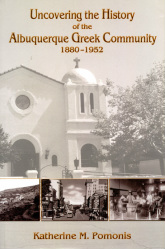Uncovering the History of the Albuquerque Greek Community 1880 - 1952

Why did Greeks in the late 1800s cross a sea, an ocean and a continent, to start new lives in the United States? Why did they eventually migrate to a small dusty town in the desert Southwest? How did Albuquerque become a center of Greek-America in the 1930s? And how did the decision to build the church in 1944 in the Huning Highland originate from a tragic event? This book answers these questions and more. It also details the compassionate response of the community to the appearance of Greek ''lungers'' seeking the cure to the ravages of tuberculosis, and traces the decision to establish in 1937 in Albuquerque the Nation's only Greek-American tuberculosis sanatorium. This book begins with the first Greeks coming, at the turn of the nineteenth century, to Albuquerque with the railroad. It details how they began immigrating to the town in large numbers after the First World War, and shows how, by the 1920s, these indomitable men owned and operated numerous businesses in the heart of new Albuquerque. It also shows how their brides made their own unique contribution by transforming the Greek population into a community. They assimilated into the United States and contributed to Albuquerque's ethnic and cultural diversity. This country gave them opportunity, and in turn, they gave their best.
Katherine M. Pomonis, a Santa Fe, New Mexico native of Greek descent, received a B.A. in History and Anthropology from the University of Rhode Island. She subsequently worked at the University of New Mexico's Maxwell Museum of Anthropology, both as a staff member and as guest curator to numerous exhibits including ''Greek Byzantium Revisited'' and ''The Greeks of America.'' She served as President of the New Mexico Association of Museums and was on the Board of the Maxwell Museum Association. She is also a member of the New Mexico State Historical Society, Historic Albuquerque Inc., and the Albuquerque Archaeological Society.
Katherine M. Pomonis, a Santa Fe, New Mexico native of Greek descent, received a B.A. in History and Anthropology from the University of Rhode Island. She subsequently worked at the University of New Mexico's Maxwell Museum of Anthropology, both as a staff member and as guest curator to numerous exhibits including ''Greek Byzantium Revisited'' and ''The Greeks of America.'' She served as President of the New Mexico Association of Museums and was on the Board of the Maxwell Museum Association. She is also a member of the New Mexico State Historical Society, Historic Albuquerque Inc., and the Albuquerque Archaeological Society.